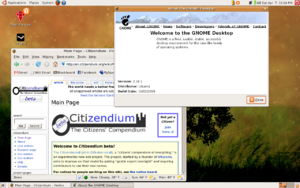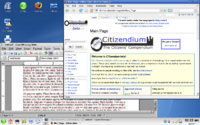Linux (operating system)
| Linux |

|
| The GNOME desktop on Ubuntu Linux 6.10 |
| Website: http://www.linux.org |
| Developer: The Open Source community |
| OS family: Unix-like |
| Source model: Open source |
| Latest stable release:[1] |
| Supported platforms: x86, x86-64, ia64, DEC Alpha, Motorola 68k, SUN Sparc, ARM, PowerPC |
| Kernel type: Monolithic kernel |
| Default user interface (most distros): GUI |
| License: GNU General Public License |
| Working state: Current |

Linux is an operating system notable for its community-driven development process, stability and security. It can run on the same IBM compatible PC hardware as the Windows and Macintosh operating system families and provides a user and developer experience that is nearly identical to the much older Unix operating system. Its feature set is comparable to the commercial operating systems sold by Microsoft and Apple.
Linux is open source software, which means it is written, and improved upon, through a community effort, and it can be obtained and used for free by anyone. Furthermore, numerous companies are able to earn money by offering "supported distributions" of Linux which have certain guarantees in terms of reliability; customers who pay for one of the "supported" versions of Linux (such as Red Hat, or others) can rest assured that someone will help them if a serious problem arises. These specially packaged versions of Linux are called Linux distributions.
Linux has experienced marketplace success both as a server (accessed remotely over a network by multiple users simultaneously) and as a single-user desktop. Furthermore, it can run on a variety of hardware platforms, including, including Intel i686, AMD64, SPARC, and Xbox systems.
Origins
In 1991, the first Linux kernel was written by an upstart college student from Finland named Linus Torvalds. It was originally started as a hobby and a free solution to the very expensive, commercial Unix systems. Indeed, it was never intended to gain the amount of attention it has acquired, largely due to the fact that Torvalds did not believe that it, having been written for the i386 platform, could be ported to other system architectures.
The name 'Linux' was created by combining Linus with the "x" in Unix. Torvalds originally intended to call the project Freax, for Free and Freak, with the "x" denoting that it is Unix-like, but after one of his colleagues named the system's FTP directory after him, the name stuck.[2] Linux is pronounced like 'Minix' - that is, "'li' is pronounced with a short [ee] sound: compare prInt, mInImal etc.'nux' is also short, non-diphtong, like in pUt."[2]
Before Torvalds began the Linux kernel project, the only low-cost, stable, Unix system developed for IBM-compatible PCs was a closed source system called 'Minix', developed by a professor named Andrew Tanenbaum. In 1984, Dr. Richard Stallman founded the landmark Free Software Foundation, a non-profit organization, in which work was done throughout the late 1980's towards creating a free Unix-like operating system. The new software was to be called the GNU[3] system, which is a recursive acronym for GNU's Not Unix. The GNU project produced highly successful tools, including the GNU C compiler, GNU debugger, and the Emacs text editor. However, the project still lacked a kernel for its new operating system. When Linux came along, the GNU developers adopted it and combined their tools with it, creating a full-fledged operating system with good tools. Stallman's Free Software Foundation was the first open source software project, and Linux became its poster child.
The GNU Project members decided to call 'Linux' GNU/Linux, in order to attribute credit to those who worked hard at creating the tools that the Linux kernel runs. Torvalds, however, has made no effort to hide his thoughts towards this naming convention, saying that "calling Linux in general just 'GNU/Linux' I think is ridiculous."[4] The name remained simply 'Linux'.
Marketplace successes and struggles
Linux is typically used either as a server (accessed remotely over a network by multiple users simultaneously), as a single-user desktop, or in some cases, both ways at once. When used as a server, Linux may be running either web server software, or database software, or both. The introduction of the Apache web server was one of the biggest breakthroughs in the entire open source community. Due to the fact that the developer community for the Linux platform has been considerably larger than that of the other platforms Apache supports, many companies rely on Linux to host their websites. Among the chief reasons for them to switch at the time of Apache's first release was the ability to host more than one website on the same computer. Other large reasons it has excelled in the server market include that it is stable, fast, and generally costs less to obtain (for both software and hardware) than other server platforms.
Linux has been somewhat less successful in the marketplace when used as a desktop. One likely reason is that the open source community has failed to standardize a user interface for the desktop, but rather, at install time, each Linux computer can be configured to run one of several desktop environments, such as GNOME or KDE. This means that a computer user cannot depend on any two Linux computers being identical to use. Despite this lack of standardization (and increased learning curve for all users), some purchasing organizations have turned to using Linux in rebellion at the cost of proprietary operating systems, especially Microsoft Windows.
Applications running on Linux
Aside from the GNU project's applications, Linux is capable of running many applications of all natures, from games and graphic editors to Integrated Development Environments and web servers. Among the most commonly used applications are The GIMP photo editing tool, which is commonly referred to as a free alternative to Photoshop, Firefox, a feature-complete, tabbed web browser, and OpenOffice, which is a free, full-featured alternative to the Microsoft Office suite. The GIMP, Firefox and OpenOffice are all cross-platform as well, meaning they run on Microsoft Windows and Mac OS X.
Unlike Microsoft Windows NT, Linux itself is not a graphical system. Instead, Linux relies on a graphical layer to output bitmap images. The most common application for this is called X.org, commonly referred to as just X. X.org is a very minimal program that purposely does as little as possible. Users do not normally see it, but the results of its work. X.org serves as a layer between the kernel and the desktop environment or window manager. Window managers, like Openbox or wmii, are only able to manage windows and desktops, while desktop environments, such as GNOME, KDE and Xfce, provide advanced graphical functionality, such as the ability to process text, organize photos or chat online.
References
- ↑ "Top 10 Distributions". Retrieved on 2007-04-09.
- ↑ 2.0 2.1 USENET post on Linux naming (Retreived 06 April 2007).
- ↑ About the GNU Project (Retreived 06 April 2007).
- ↑ The "GNU/Linux" and "Linux" Controversy (Retreived 06 April 2007).
